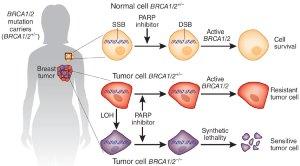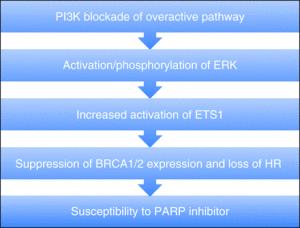This week’s Cancer Discovery had 2 exciting articles on combining PI3K inhibitors with PARP inhibitors in breast cancer. I was particularly intrigued as these papers have a solid mechanistic explanation of the mechanism of synergy so I thought I would do a post on the 2 papers. But first a little background…
PARP enzymes play important roles in a specific type of DNA repair pathway called BER (or base excision repair). PARP inhibitors have been developed to inhibit DNA repair in tumor cells that have other defects in DNA repair, such as BRCA1 or BRCA2

Figure 1: Synthetic lethality in the setting of BRCA1/2 mutation (From: Polyak K, Nature Med 2011)
mutant breast and ovarian cancers (which have defective homologous recombination). This concept is what is known as a synthetic lethal relationship (see figure 1 for schematic) – either defect alone doesn’t have much effect, but when combined together do have an effect (ie cell killing). Several PARP inhibitors have been developed, including olaparib and MK-4827, which have been tested in patients with BRCA1/2 mutations. The results from these trials have been somewhat promising, with response rates between 30-40% without considerable toxicity. However these responses have not been very durable.
BRCA1 and BRCA2 germline mutations only account for 5-10% of all breast cancers however, so researchers have been trying to figure out whether PARP inhibitors might have some utility in patients who have not inherited these alleles. This is where these new papers come in.
So why the excitement about combination with PI3K inhibition? There are 2 reasons:
* Combinations of PARP inhibitors and cytotoxic chemotherapy is effective in preclinical studies, however in patients unfortunately the toxicities are also additive, especially immunosuppression, which leads to dose reductions/delays. These results suggest that the therapeutic window for these treatment strategies may actually be pretty narrow.
* We already know that the PI3K pathway is highly relevant in most breast cancers in different contexts –as primary genetic defects or as resistance mechanisms to endocrine/HER2-targeted therapy. Specifically in triple negative breast cancer for example, alterations include PTEN mutations, INPP4B phosphatase loss and PIK3CA activating mutations (rarer). Unfortunately despite expressing these potential biomarkers of sensitivity to PI3K inhibition, cancer cells are really smart, and if we just use PI3K inhibitors alone, feedback loops are quickly turned on to help cells survive, so combinations with PI3K inhibitors are definitely going to be the way forward. In addition, it is known that BRCA1-mutant breast tumors have elevated PI3K pathway activity.
To briefly summarize the 2 papers, starting with my favorite of the 2:
“Ibrahim et al, “PI3K inhibition impairs BRCA1/2 expression and sensitizes BRCA-proficient triple-negative breast cancer to PARP inhibition” was interesting because the premise of the whole paper is that regular triple negative breast cancers could be made more like BRCA-mutant breast cancers via PI3K inhibition. This is called “BRCAness” and is actually a pretty neat concept, since there is data showing that among triple negative tumors, those with BRCA1/2 mutations actually respond to chemotherapy better. So why would PI3K inhibition cause “BRCAness”? It has been known already that PI3K can regulate steady state levels of homologous recombination, so the authors took one of my favorite cell lines MDA-MB-468 which has wild-type BRCA, and knocked down either BRCA 1 or PIK3CA (the catalytic subunit of PI3K), and observed an increase in cells with gamma H2AX, a marker of DNA damage. This phenomenon was also seen with the pan PI3K inhibitor NVP-BKM120. They went on to explore the mechanism further, and showed that PI3K inhibition decreased BRCA1/2 protein level both in cell lines and in 2 out of 3 xenograft models taken from patients which correlated with response to PARP inhibitor treatment. And finally they carefully dissected out the mechanism by PI3K inhibitors decreased BRCA expression, and found the pathway to be via ERK activation of ETS1 transcription factor. The overall model they proposed is in figure 2.

Figure 2: Model for synergistic activity (From: Rehman FL et al, Cancer Discovery 2012 “In the Spotlight”)
The second study: “Juvekar et al, “Combining a PI3K inhibitor with a PARP inhibitor provides an effective therapy for BRCA1-related breast cancer” basically showed that in a transgenic mouse model of BRCA1-hereditary breast cancer, that both olaparib (the PARP inhibitor) and the PI3K inhibitor NVP-BKM120 could inhibit tumor growth by some degree alone, but when given together caused a 14-fold delay in tumor growth. The growth curves are pretty impressive given that these tumors grow exceedingly rapidly! Tumor growth inhibition by Pi3K inhibition involves many pathways, and they show specifically inhibition of AKT as a pharmacodynamic marker, as well as decreases FDG-uptake as a functional readout. Angiogenesis (growth of new blood vessels) is also significantly decreased by BKM120 treatment.
The mechanism of synergy that they go on to explore involves PI3K inhibition blocking DNA repair via impaired Rad51 recruitment to DNA damage combined with the already existing defect in homologous recombination repair. As a result the tumor cells would become more dependent on PARP-mediated repair, so if you then add a PARP inhibitor, you kill them better. However if the tumors relapsed, these markers of DNA damage were increased over baseline and MAPK signaling could compensate for PI3K survival signals.
In closing, here are a few take-home points I took from both studies together
* Based on the mechanism of action, I would postulate that combining ERK inhibitors in triple negative breast cancer with PI3K inhibitors and PARP would be counterproductive.
* Method-wise, I liked that both studies used patient-derived xenograft models which are now being viewed as superior models to traditional cell-line derived xenografts. The fact that the Juvekar study saw greater synergy in vivo versus in cell lines, points to why doing such studies in animals is important and may lead to greater insight into mechanisms of action that are not cancer cell-intrinsic.
* Trials with PARP inhibitors and PI3K inhibitors should now routinely be adding gamma H2AX as a pharmacodynamic marker to show that the drugs are working.
References (both free! 
Ibrahim et al paper: http://cancerdiscovery.aacrjournals.org/content/2/11/1036.full
Juvekar et al paper: http://cancerdiscovery.aacrjournals.org/content/2/11/1048.full
